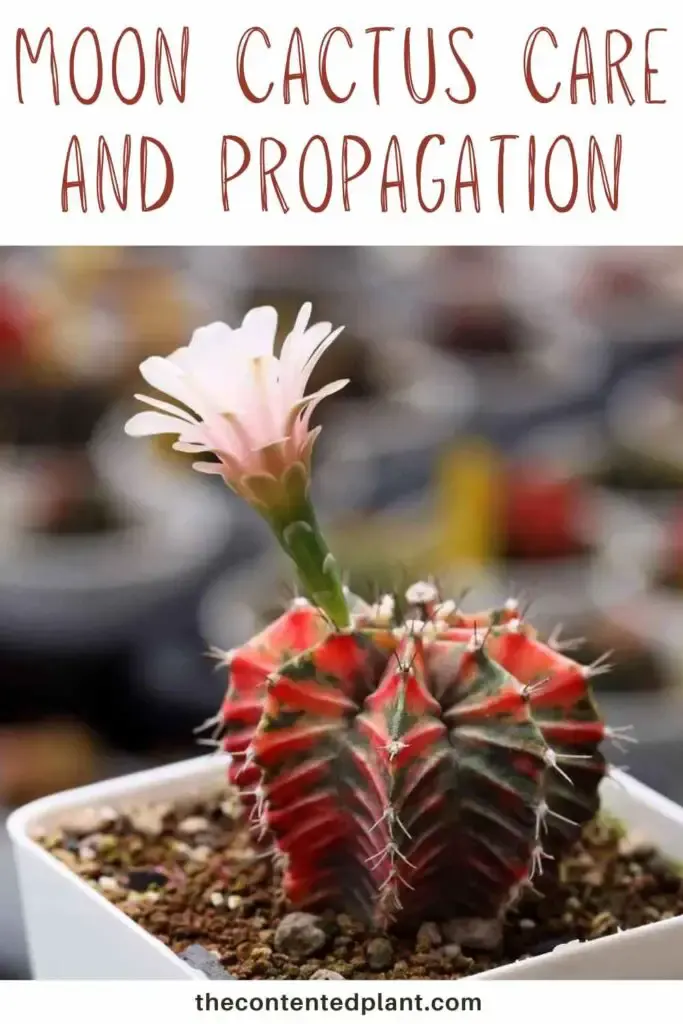The grafted Moon Cactus, (Gymnocalycium mihanovichii) is a popular species of cactus that belongs to the Cactaceae family. It is native to South America, specifically to Argentina and parts of Uruguay, Paraguay, and Brazil. This cactus is also known as Ruby Ball, Red Cap, Red Hibotan, or Hibotan cacti. In this post we discuss moon cactus care, propagation and other interesting info on this fascinating cactus.
This adorable cactus is normally sold with an intensely colored top on a green base. It’s undeniably cute. However, there is a lot of backstory to this plant. In nature, a moon cactus grows as grey green cactus. You won’t find the brightly colored moon cactus we see in plant shops, if you stumble upon it in the wild. Here’s why.
Today’s Moon Cactus has undergone some major changes from its natural wild form. Its current cultivated and commercialized version is smaller in size, and has a more flattened shape than the wild plant. But what you will likely notice most is all the vibrant colors that are not naturally present in the wild.
Through genetic manipulation, hybridization, and grafting techniques the modern version of moon cactus was created. Grafting the mutated moon cactus onto a chlorophyll producing base plant feeds the Moon Cactus through the base plants photosynthesis process.
So how did this plant get to be a stitched together Frankenstein style plant mutation? The history of this cactus’s metamorphic rise into a common commercial plant begin in the mid 20th century.
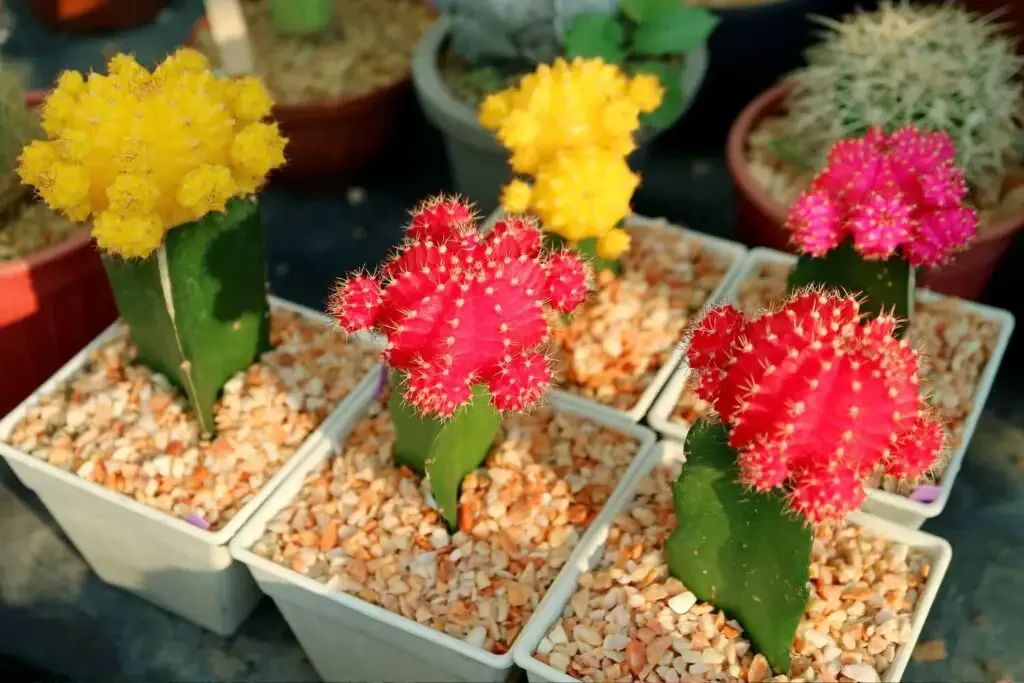
The modern day, colorful Moon Cactus varieties originated from a single nurseryman’s efforts in Japan in the mid-20th century. He took the naturally occurring occasional color mutations from the wild stock and created, through mutation and hybridizations over time, the astonishingly brightly colored moon cactus.
But his plant creations had no chlorophyll, which plants need to feed themselves. So he grafted his intensely colored small cactus onto a green cactus that feeds the top through photosynthesis.
The result is an interesting cactus of small stature. The average mature Gymnocalycium mihanovichii plants reach a diminutive diameter of about 2 to 4 inches (5 to 10 centimeters) and a height of around 2 to 4 inches as well.
The Moon Cactus are well loved by plant enthusiasts. This is an eye catching cactus. Its small size also makes it perfect for an indoor plant. Love em? You can easily make a collection of the various colors for your home.
The Moon Cactus is a popular choice for indoor gardening, succulent arrangements, and dish gardens. It is generally easy to care for, like most cactus, requiring well-draining soil, bright but indirect sunlight, and infrequent watering.
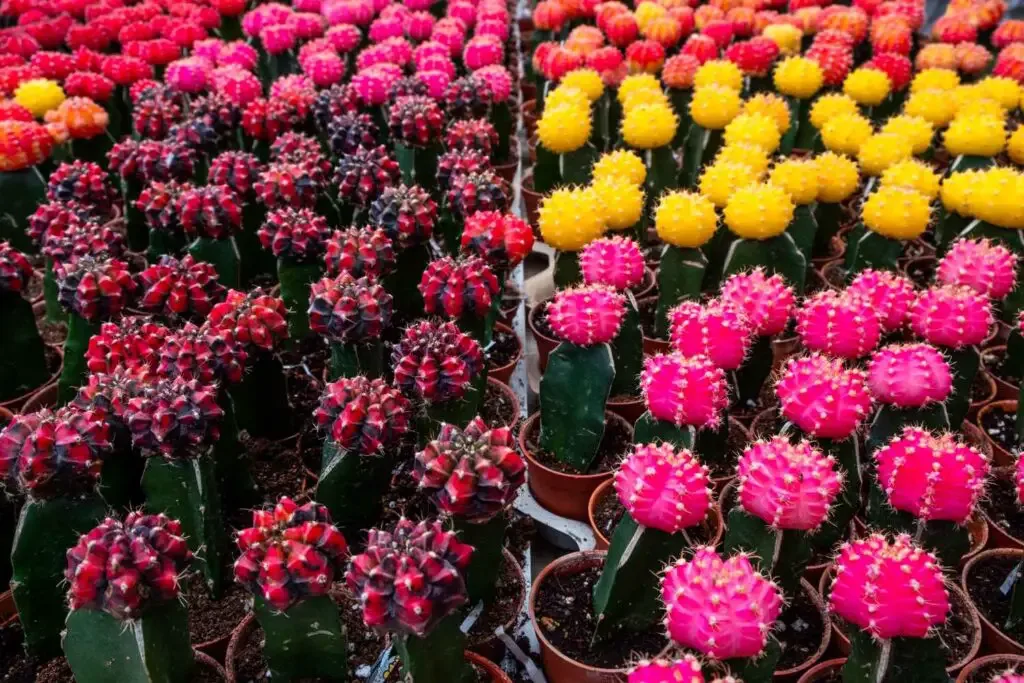
Moon Cactus Care:
The cultivated and grafted Moon cactus are a bit more sensitive to their care than cactus we find toughing it out in nature. You will want to pay attention to these care tips for the best results with your cactus.
| Aspect of Care | Description |
|---|---|
| Light | Bright, indirect sunlight. Protect from intense midday sun. |
| Temperature | Warm temperatures; ideally between 70-80°F (21-27°C) during the growing season and not below 50°F (10°C) in winter. |
| Watering | Water sparingly and allow the soil to dry out between waterings. Avoid overwatering to prevent root rot. |
| Soil | Well-draining cactus or succulent soil mix. |
| Fertilization | Use a diluted, balanced liquid fertilizer during the growing season (spring and summer) about once a month. Avoid fertilizing during winter. |
| Graft Care | If grafted, monitor the health of both the colorful top (scion) and the rootstock. |
| Pruning | Remove any dead or rotting tissue carefully to prevent the spread of diseases. |
| Pests | Watch for common cactus pests like mealybugs or scale insects. Treat with insecticidal soap if infestations occur. |
| Repotting | Repot when the cactus becomes too large for its current container or every 2-3 years. |
| Propagation | Moon Cacti are typically propagated through grafting rather than traditional methods like seeds or offsets. Learn more below on grafting. |
| Longevity | Moon Cacti have a shorter lifespan compared to some other cacti, often around 2-10 years. |
These are the most common general care tips for your cactus. However, Keep an eye on your cactus and adjust the care based on the plant’s response to it. This will help you provide the best care for your cactus and keep it happy.
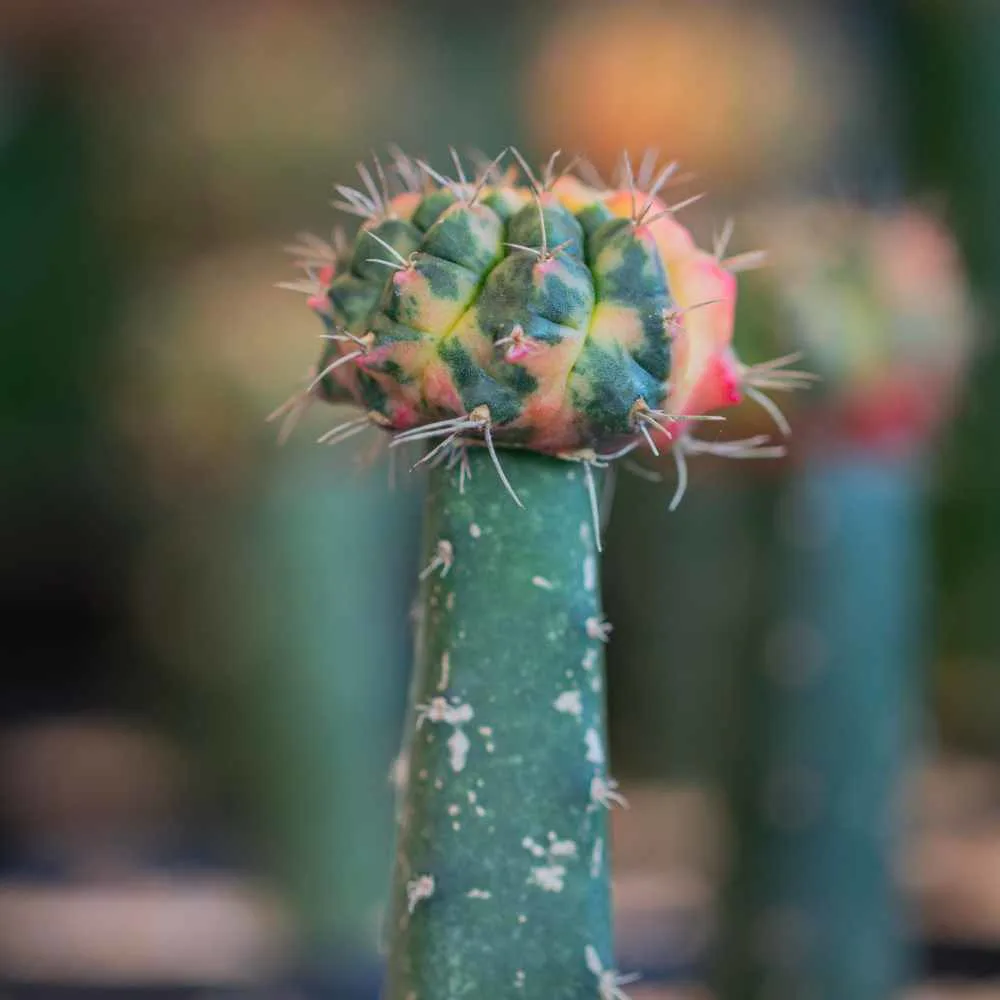
Propagating the Moon Cactus:
Propagating a Gymnocalycium mihanovichii, or Moon Cactus, can be done through a process called grafting. Since moon cactus lack chlorophyll and cannot produce food through photosynthesis, it requires a rootstock (host plant) with chlorophyll to provide nutrients.
By grafting the colorful Gymnocalycium mihanovichii onto a green, chlorophyll-containing rootstock, the top is able to connect and feed from the base plant. The result is colorful, non-chlorophyll-containing top poised on a green cacti base. That’s how it receives nutrients. The rootstock supports the top.
*Choosing the Scion:
If you have a moon cactus top that is losing its graft, you can redraft it onto a new host cacti. Or graft offsets. what are they?
Even though the colorful top of the Moon Cactus can’t carry out photosynthesis, it still contains stored nutrients from the grafted rootstock cactus. These stored nutrients can support the growth of offsets or pups. You can graft these offset growths and make new moon cacti.
Select a Healthy top or Pups: Choose well-developed and healthy offsets that have a good chance of survival. Look for pups that are large enough to be handled and have their own roots starting to form. Keep in mind that grafting requires some skill and practice. Don’t be disappointed with your first efforts don’t work out.
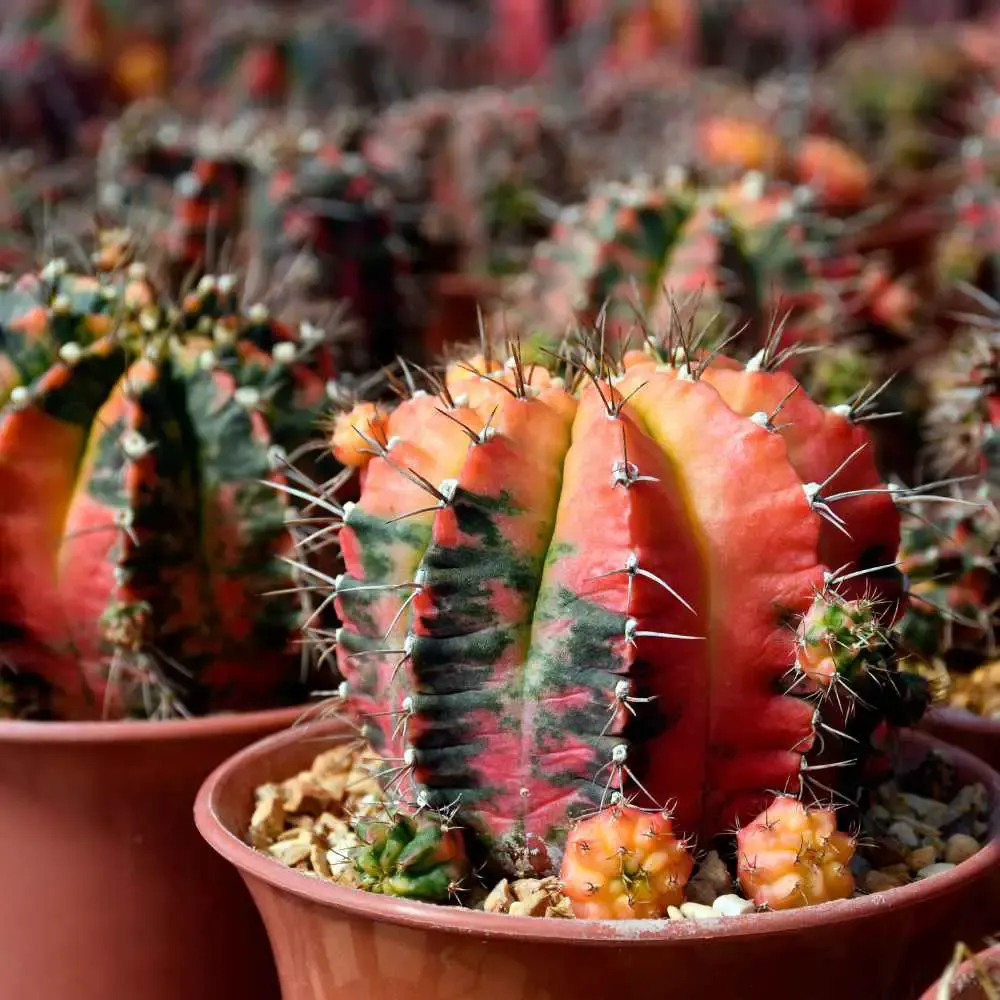
**Choosing The Rootstock:
There isn’t a single specific cactus that’s universally used as the best choice of rootstock cactus for grafting Moon Cactus. However, certain cactus species are more commonly used as rootstocks due to their compatibility and ability to provide the necessary nutrients. Some popular choices for rootstock cacti include:
- Hylocereus spp. (Dragon Fruit Cactus): This is one of the more common choices for grafting Moon Cacti. Dragon Fruit Cactus is a fast-growing and adaptable cactus that can provide ample nutrients to the colorful top of the Moon Cactus.
- Pereskiopsis spp.: This is a smaller, often green cactus that is frequently used as rootstock for grafting various cactus species, including Moon Cacti. Pereskiopsis is known for its rapid growth and ability to support the growth of grafted segments.
- Epiphyllum spp. (Orchid Cactus): Epiphyllum cacti are known for their flat, leaf-like stems and large, showy flowers. They can also be used as rootstocks for grafting Moon Cacti.
- Selenicereus spp. (Night-Blooming Cereus): Similar to Hylocereus, some species of Night-Blooming Cereus are used as rootstock due to their relatively quick growth and compatibility.
These are just a few examples. Other cacti can also serve as suitable rootstocks. The key is to choose a cactus that grows relatively quickly, has a similar growth habit, and can provide the necessary nutrients for the grafted Moon Cactus.
When selecting a rootstock, consider factors like growth rate, compatibility, availability, and how it’s going to look when finished. Different rootstock choices impact the growth rate, appearance, and overall health of the grafted Moon Cactus.
If you’re interested in grafting Moon Cacti, you can experiment with different rootstocks to find the one that works best for you and your growing conditions.
Propagate a Moon Cactus through grafting:
Grafting Materials Needed:
- Healthy Gymnocalycium mihanovichii (scion)*
- Healthy green cactus with chlorophyll (rootstock)**
- Sterilized sharp knife or scalpel
- Rooting hormone (optional)
- Grafting tape or rubber bands
- Pot with well-draining cactus soil mix
Grafting The Moon Cactus:
- Select Your Plants: Choose a healthy Gymnocalycium mihanovichii (the top colorful part), or offset, on it that you want to propagate (scion). Also select a healthy green cactus with chlorophyll (rootstock) that will serve as the base for grafting.
- Prepare the Rootstock: Carefully remove a section of the green cactus’s stem. This section will act as the rootstock onto which you will graft the Cactus scion. Make a clean, horizontal cut on the rootstock cactus.
- Prepare the Scion: Trim the bottom of the Gymnocalycium mihanovichii (the colorful part) at a slight angle. This will create a surface that fits snugly onto the cut surface of the rootstock.
- Grafting: Place the trimmed bottom of the scion onto the cut surface of the rootstock. Ensure a good fit so that the scion makes good contact with the rootstock. You can optionally dip the cut end of the scion in rooting hormone before placing it on the rootstock.
- Secure with Grafting Tape: Use grafting tape or rubber bands to secure the scion onto the rootstock. This will hold the two parts together and allow them to heal and fuse over time.
- Healing and Growth: Place the grafted cactus in a warm and bright location, but avoid direct sunlight. Over time, the scion and rootstock will begin to fuse. New growth should emerge from the scion. Keep the cactus away from extreme temperature changes.
- Care: As the graft heals and the cactus grows, water sparingly. The rootstock will provide the necessary nutrients for the Moon Cactus to thrive.
- Transition to Regular Care: Once the graft has successfully fused and new growth is evident, you can treat the grafted Moon Cactus more like a regular cactus. Continue to provide adequate light, water, and care based on the needs of the rootstock cactus.
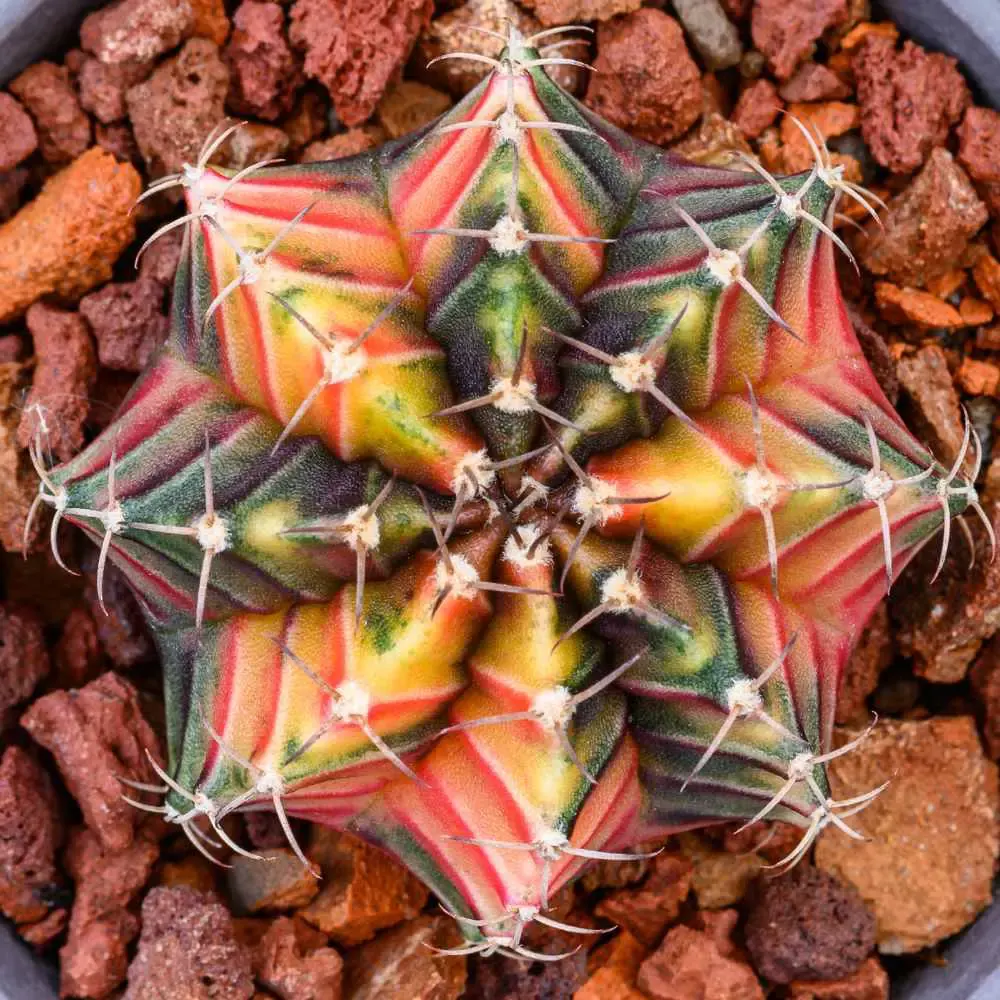
Grafting can be a bit challenging, especially for beginners, so it’s a good idea to do some research and possibly practice on less valuable plants before attempting to propagate your Moon Cactus.
Even the best graft cannot last indefinitely. As the host plant grows at a different rate than the moon cactus. Eventually the pressure on the graft is too much and the graft will split apart.
This cactus does pay a price for living off another plant. The moon cactus is not long lived, as cactus lifespans go. Over time, they become susceptible to rot and other issues. This plant dies easily in poor conditions, or if it has a bad graft.
It might live a year… or, with luck, you may enjoy it up to ten years.
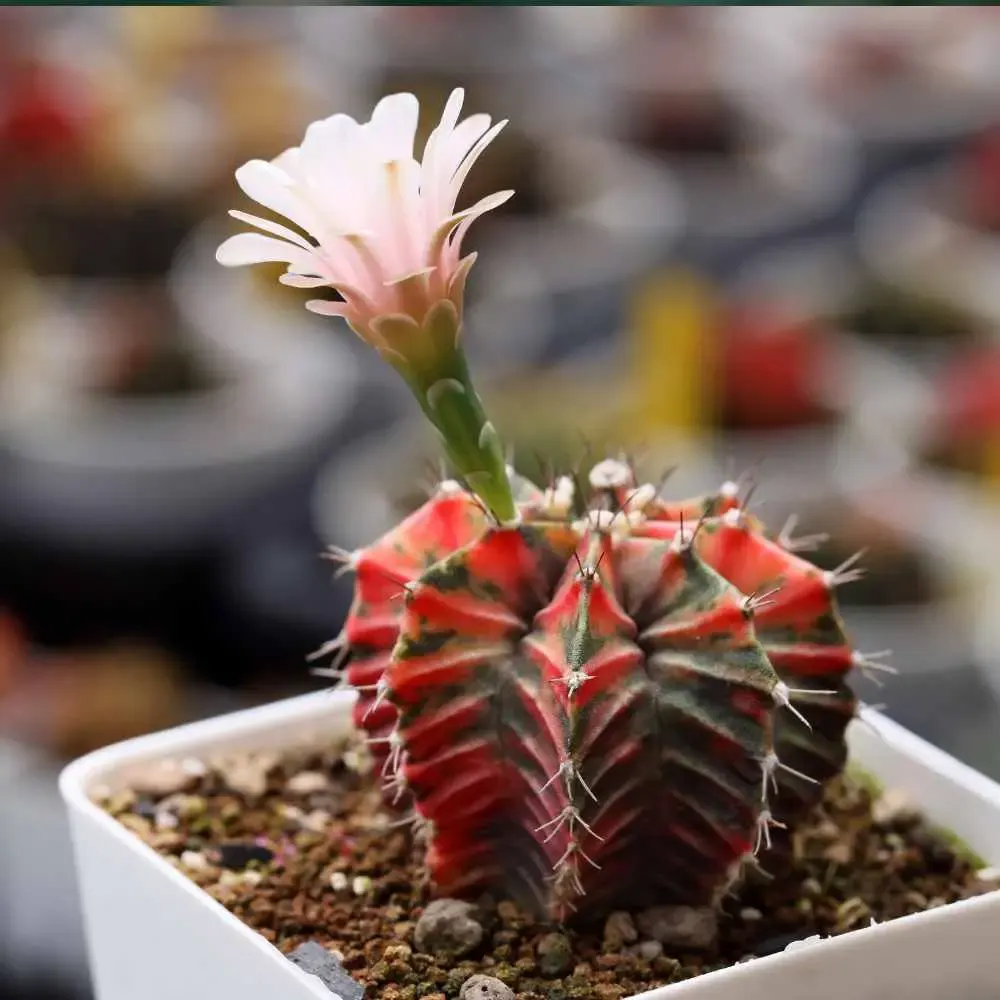
Moon Cacti Flowers:
Moon Cacti (Gymnocalycium mihanovichii) will produce flowers under the right conditions. The colorful top part of the Moon Cactus, can bloom with beautiful flowers. But not all Moon Cacti will bloom every year.
The flowers are small but appear various colors, including shades of pink, purple, white, and yellow. The blooms are often relatively short-lived compared to some other cactus flowers, lasting anywhere from a few days to a week or so.
For Moon Cacti to flower, they require appropriate care, including proper lighting, temperature, and care routines. Providing bright but indirect sunlight, maintaining suitable temperatures, and providing occasional fertilization during the growing season can encourage blooming. A period of cooler temperatures or a slight reduction in watering can sometimes trigger flowering.
While the colorful top of the Moon Cactus is its main attraction, its flowers are definitely an added bonus. If your Moon Cactus blooms, enjoy!
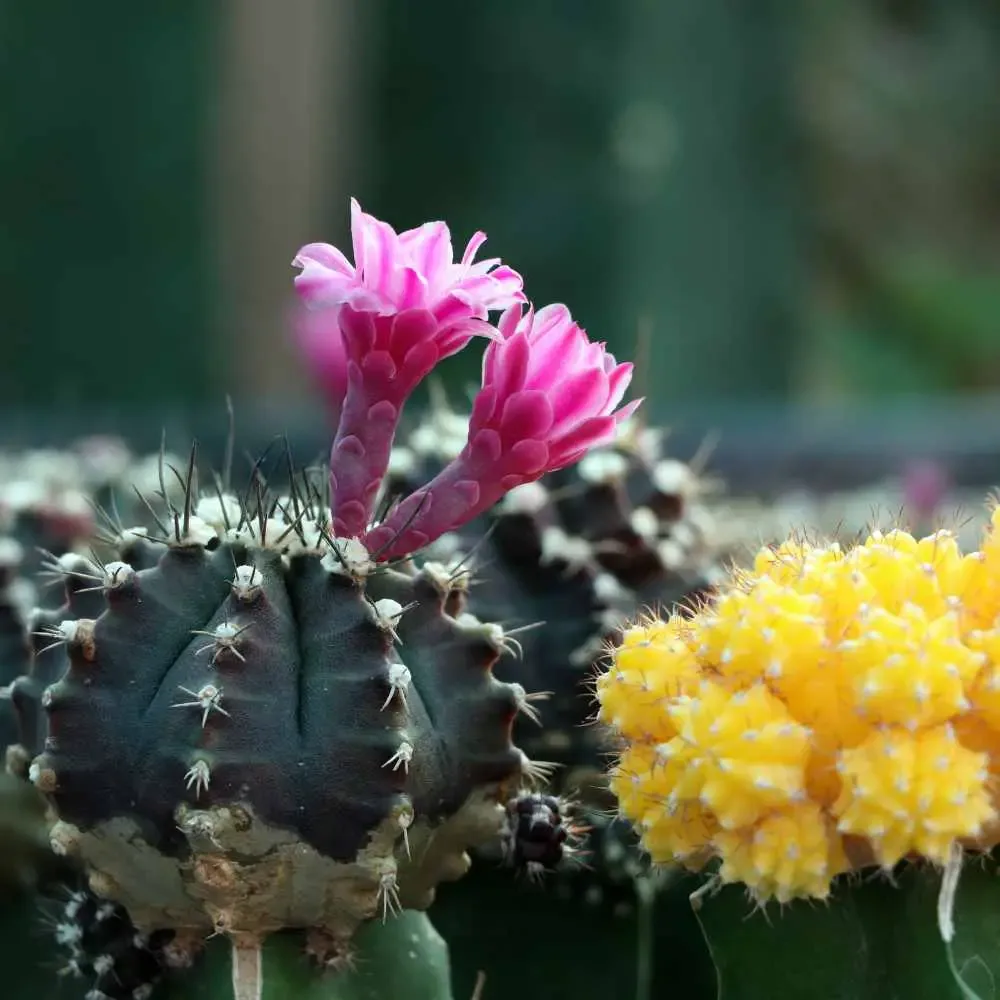
Related Content:
If you are a cactus lover, here are a few more cacti we think you should meet.
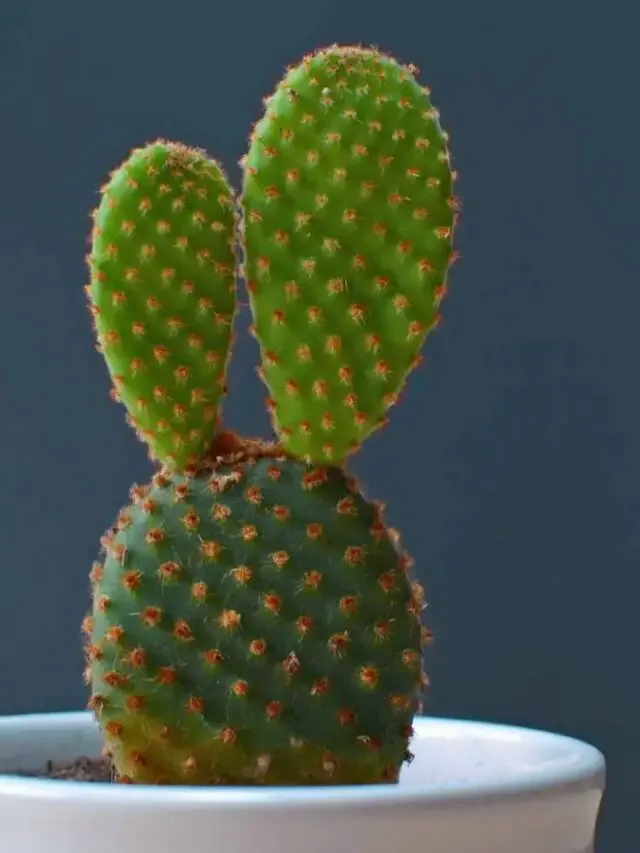
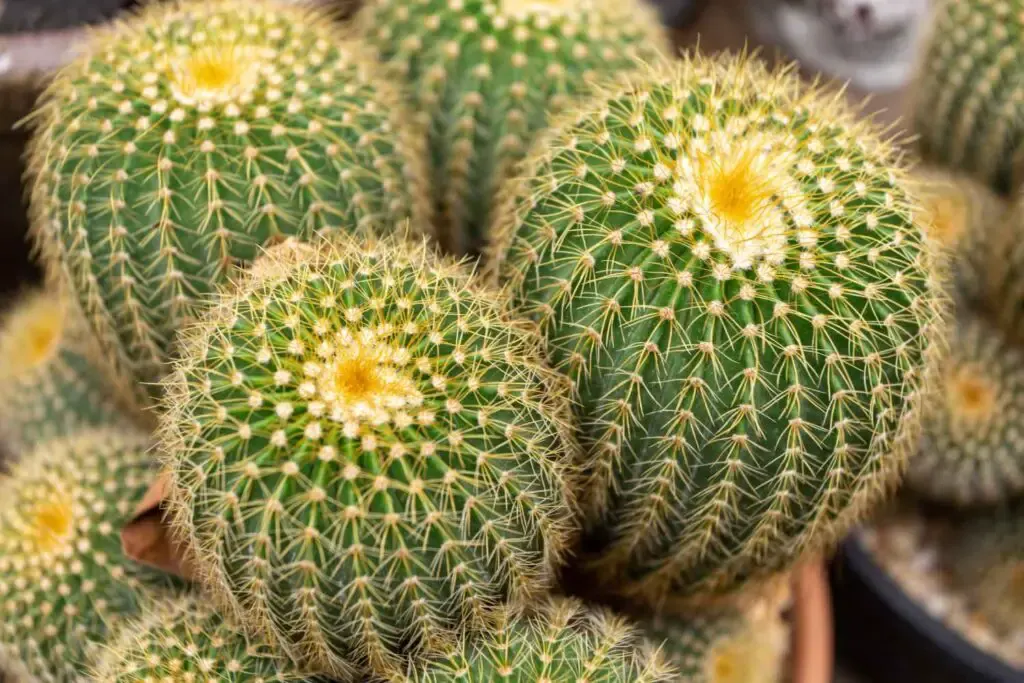
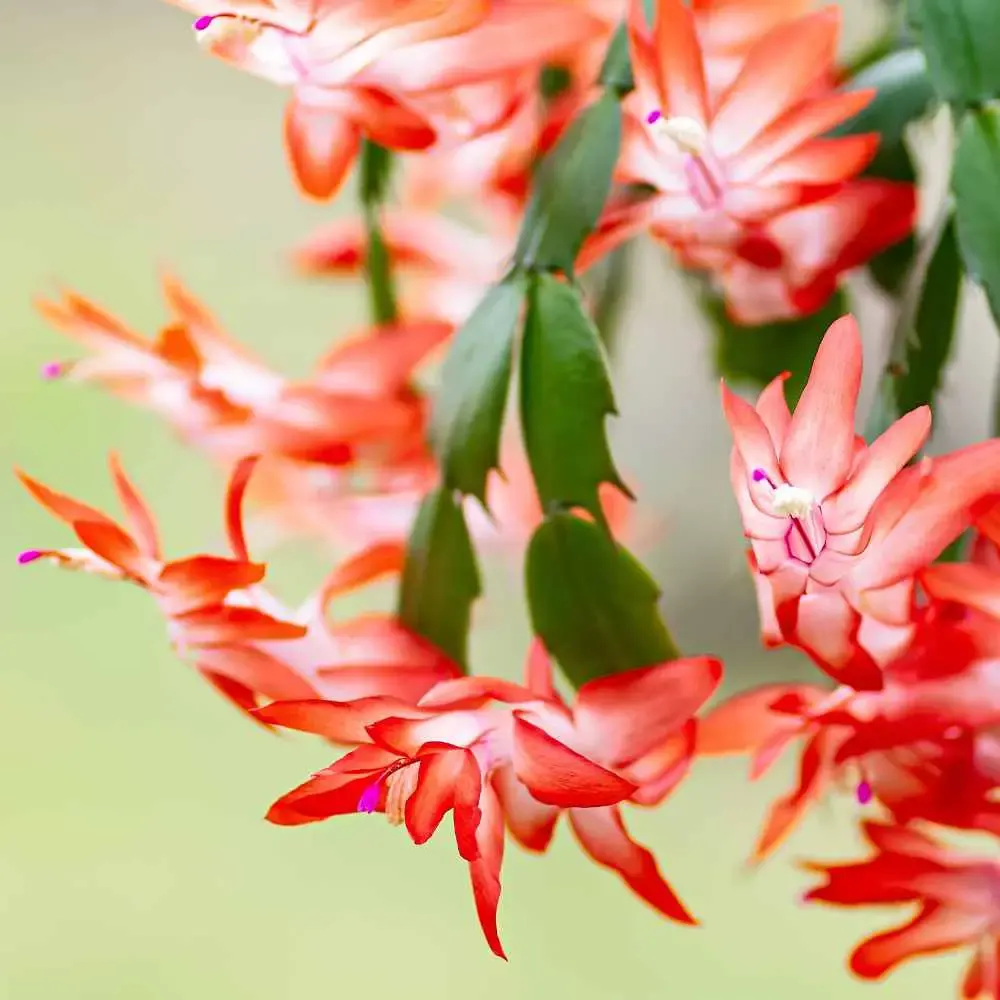
Follow Us:
Find us on YouTube, Instagram , Pinterest and TikTok! We love to Plant chat. We also comment, like and occasionally share your content to our daily stories. We’d love to see your plants. Share your joy in your houseplants. Happy Planting!
